By John Treadwell Dunbar ——Bio and Archives--May 30, 2012
Travel | CFP Comments | Reader Friendly | Subscribe | Email Us
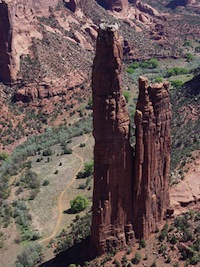 I didn't know Spiderman had a lady friend living in Arizona, or that she lived atop the taller of two spires known as Spider Rock in Canyon de Chelly (pronounced “Duh Shay”), a large sheltered gorge of multiple canyons in the otherwise mundane brown terrain west of the Chuska Mountains. To outsiders, Canyon de Chelly near Chinle is a desolate and remote place, a thing of such unusual beauty it has become a mandatory stop on anyone's Southwest itinerary. Inhabited continuously for roughly 5,000 years by Native Americans, including the cliff-dwelling Anasazi, this is one place we just had to see for ourselves.
Determined to locate this mystery woman, I stood on the south rim staring out at iconic Spider Rock, zooming and telescoping patiently as I brought the 800-feet-tall, free-standing monolith into focus, sweeping my fading eyes over the wind-swept, sandstone pillars familiar to anyone with a television set - it's a popular backdrop for commercials.
I didn't know Spiderman had a lady friend living in Arizona, or that she lived atop the taller of two spires known as Spider Rock in Canyon de Chelly (pronounced “Duh Shay”), a large sheltered gorge of multiple canyons in the otherwise mundane brown terrain west of the Chuska Mountains. To outsiders, Canyon de Chelly near Chinle is a desolate and remote place, a thing of such unusual beauty it has become a mandatory stop on anyone's Southwest itinerary. Inhabited continuously for roughly 5,000 years by Native Americans, including the cliff-dwelling Anasazi, this is one place we just had to see for ourselves.
Determined to locate this mystery woman, I stood on the south rim staring out at iconic Spider Rock, zooming and telescoping patiently as I brought the 800-feet-tall, free-standing monolith into focus, sweeping my fading eyes over the wind-swept, sandstone pillars familiar to anyone with a television set - it's a popular backdrop for commercials.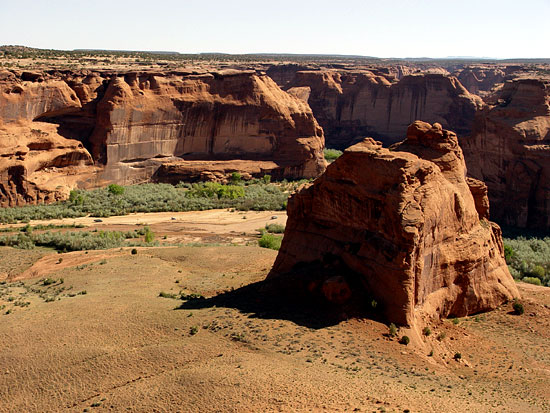 While free to peer to your heart's delight at the plunging cliffs, distant walls and lush bottom-land from the north and south rims, and even hike unaccompanied down the White House Ruins Trail, you'll need a Navajo guide or park ranger to get down in there with the marrow where the Dineh live, where 2,700 archeological sites are scattered about the numerous beige canyons, small and large, and where you'll find petroglyphs, and many ruins still standing, stabilized and protected from the elements - a mere sampling of 700 existing structures which serve as testament to ancient Anasazi culture.
While free to peer to your heart's delight at the plunging cliffs, distant walls and lush bottom-land from the north and south rims, and even hike unaccompanied down the White House Ruins Trail, you'll need a Navajo guide or park ranger to get down in there with the marrow where the Dineh live, where 2,700 archeological sites are scattered about the numerous beige canyons, small and large, and where you'll find petroglyphs, and many ruins still standing, stabilized and protected from the elements - a mere sampling of 700 existing structures which serve as testament to ancient Anasazi culture.
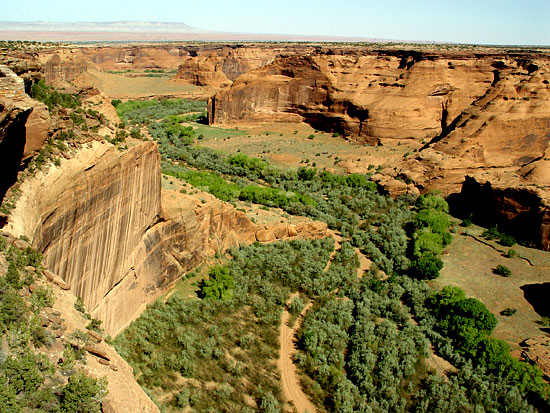 Technically a national monument, the 84,000 acres of Canyon de Chelly are not federal lands, but Navajo tribal trust lands populated by a small community of 40 Navajo families who reside in the monument proper. Some live in traditional hogans on the green, valley floor among fluorescent cottonwoods as they have for 300 years, and continue tending sheep and goats, growing crops on their small plots, and staring up at the sun dipping prematurely beneath the rim of 1,000-foot slabs of red and white sandstone walls streaked black and tan. Tough making a living here, they get by selling turquoise jewelry, and pottery adorned in elaborate patterns, and exquisite woven tapestries to visiting tourists down there near the ruins, and along the rim at strategically-placed overlooks, and in the lodges and gift shops at Chinle.
Technically a national monument, the 84,000 acres of Canyon de Chelly are not federal lands, but Navajo tribal trust lands populated by a small community of 40 Navajo families who reside in the monument proper. Some live in traditional hogans on the green, valley floor among fluorescent cottonwoods as they have for 300 years, and continue tending sheep and goats, growing crops on their small plots, and staring up at the sun dipping prematurely beneath the rim of 1,000-foot slabs of red and white sandstone walls streaked black and tan. Tough making a living here, they get by selling turquoise jewelry, and pottery adorned in elaborate patterns, and exquisite woven tapestries to visiting tourists down there near the ruins, and along the rim at strategically-placed overlooks, and in the lodges and gift shops at Chinle.
 Despite the tranquility, life hasn't always been peaceful for the people of Canyon de Chelly. In 1805, warring Spaniards fired on a large group of terrified old Navajo men, women and children hiding in an alcove way up on the side of a relatively inaccessible wall, killing 115 in a bloody hail of bullets. The Navajo call this place of disgrace 'Adah Aho' doo' nili,' and if you should scramble up to the alcove, if that's even possible, you should be able to see where Spanish bullets pockmarked the wall.
Despite the tranquility, life hasn't always been peaceful for the people of Canyon de Chelly. In 1805, warring Spaniards fired on a large group of terrified old Navajo men, women and children hiding in an alcove way up on the side of a relatively inaccessible wall, killing 115 in a bloody hail of bullets. The Navajo call this place of disgrace 'Adah Aho' doo' nili,' and if you should scramble up to the alcove, if that's even possible, you should be able to see where Spanish bullets pockmarked the wall.
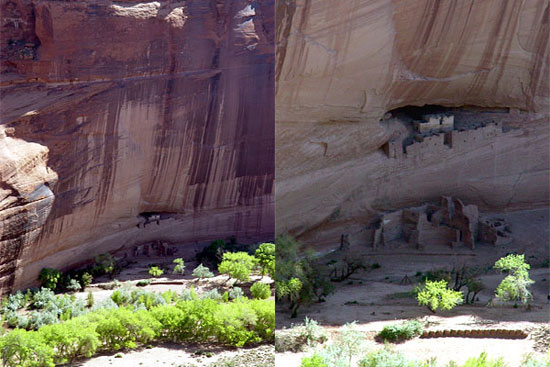 Legendary American hero, Kit Carson, the Indian-fighting butcher with blood up to his eyeballs, though initially reluctant, oversaw the Battle of Canyon de Chelly in 1864 which essentially ended the long-running Navajo Wars.
Legendary American hero, Kit Carson, the Indian-fighting butcher with blood up to his eyeballs, though initially reluctant, oversaw the Battle of Canyon de Chelly in 1864 which essentially ended the long-running Navajo Wars.
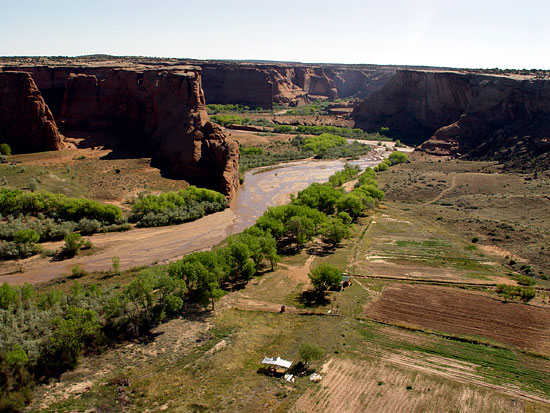 During a winter blizzard of deep snow, Kit Carson and several hundred soldiers conducted a scorched-earth policy in these canyons, marching up and down from multiple directions, torching and destroying Navajo camps, crops and supplies, and any semblance of infrastructure necessary for the Navajo's winter survival. They filled in water holes. They hunted the people down. The shameful Navajo campaign was ethnic cleansing at its worst.
During a winter blizzard of deep snow, Kit Carson and several hundred soldiers conducted a scorched-earth policy in these canyons, marching up and down from multiple directions, torching and destroying Navajo camps, crops and supplies, and any semblance of infrastructure necessary for the Navajo's winter survival. They filled in water holes. They hunted the people down. The shameful Navajo campaign was ethnic cleansing at its worst.
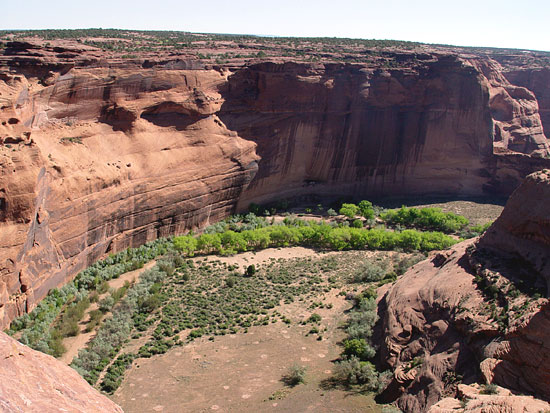 One of the remaining bands of Navajo took their last stand on top of the rocky butte known as Fortress Rock. But despite stockpiling food and sneaking down off the butte for water in the dead of night, the elements proved too much. Most of the Navajo at Fortress Rock eventually turned themselves in and joined the largest mass surrender of Native Americans in United States history.
One of the remaining bands of Navajo took their last stand on top of the rocky butte known as Fortress Rock. But despite stockpiling food and sneaking down off the butte for water in the dead of night, the elements proved too much. Most of the Navajo at Fortress Rock eventually turned themselves in and joined the largest mass surrender of Native Americans in United States history.
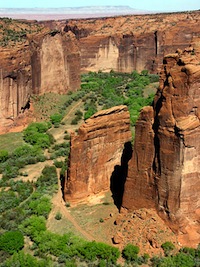 Roughly 8,000 – 9,000 men, women and children made the pointless, gruesome, deadly walk 450 miles east to the Basque Redondo reservation, near Fort Sumner, New Mexico, known to the people as Hwéeldi where they continued to endure much suffering and death.
Where was Spider Woman, you might ask, during this terribly sad period in Navajo history? Given the sheer horror, ghastly even by Syrian standards, you'd think some of those bones atop Spider Rock should have been those of Kit Carson and his men, and those whose directives they followed before, during and after the Long March. (Granted, the Americans were under orders, and yes, the Navajo did some killing of their own, … but come on ....)
Roughly 8,000 – 9,000 men, women and children made the pointless, gruesome, deadly walk 450 miles east to the Basque Redondo reservation, near Fort Sumner, New Mexico, known to the people as Hwéeldi where they continued to endure much suffering and death.
Where was Spider Woman, you might ask, during this terribly sad period in Navajo history? Given the sheer horror, ghastly even by Syrian standards, you'd think some of those bones atop Spider Rock should have been those of Kit Carson and his men, and those whose directives they followed before, during and after the Long March. (Granted, the Americans were under orders, and yes, the Navajo did some killing of their own, … but come on ....)
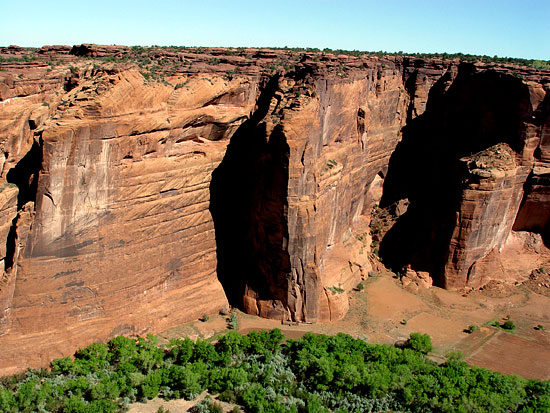 To white tourists standing near the edge of the beautiful south rim feeling warm and fuzzy being in Indian country, harmonious and bursting with indigenous vibes, and at peace with Mother Nature, the Navajo Wars might seem like just another footnote in the guide book. But the events of 1864 happened not that long ago. To the Dineh, the Long March to the place of untold sorrow and misery happened yesterday. Something to think about when you tip your guide at the end of the day.
To white tourists standing near the edge of the beautiful south rim feeling warm and fuzzy being in Indian country, harmonious and bursting with indigenous vibes, and at peace with Mother Nature, the Navajo Wars might seem like just another footnote in the guide book. But the events of 1864 happened not that long ago. To the Dineh, the Long March to the place of untold sorrow and misery happened yesterday. Something to think about when you tip your guide at the end of the day.
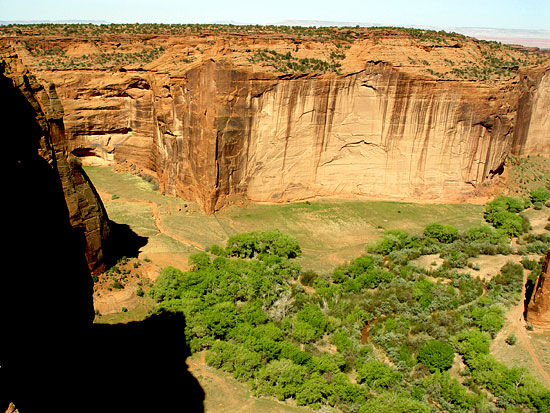
View Comments
John Treadwell Dunbar is a freelance writer